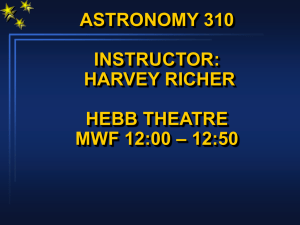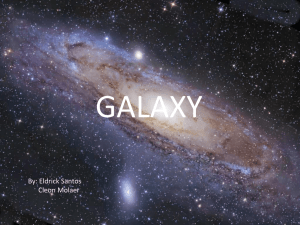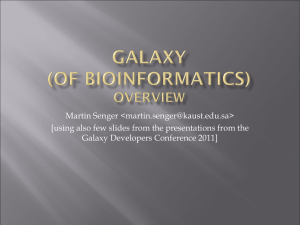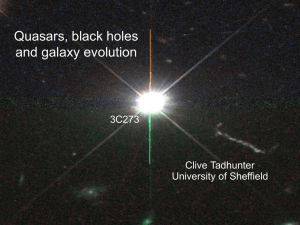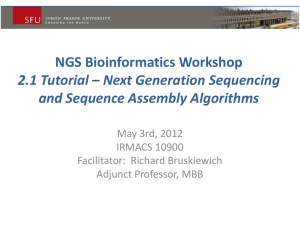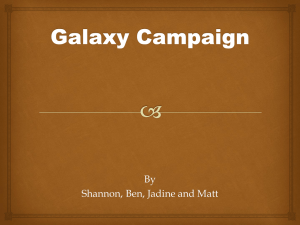Our Galaxy - Mt. SAC Faculty Directory
advertisement
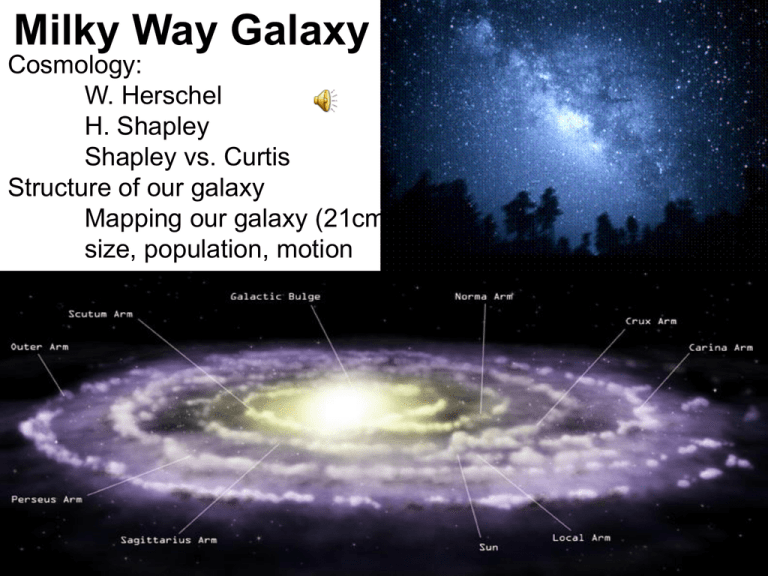
Milky Way Galaxy Cosmology: W. Herschel H. Shapley Shapley vs. Curtis Structure of our galaxy Mapping our galaxy (21cm) size, population, motion Chapter 23 By reading this chapter, you will learn 23-1 How astronomers discovered the solar system’s location within the Milky Way Galaxy 23-2 The shape and size of our Galaxy 23-3 How the Milky Way’s spiral structure was discovered 23-4 The evidence for the existence of dark matter in our Galaxy 23-5 What causes the Milky Way’s spiral arms to form and persist 23-6 How astronomers discovered a supermassive black hole at the galactic center Our Galaxy Wide-angle photograph spanning half the Milky Way, as seen from the equatorial latitudes. More than a million stars in the disk of our Galaxy fill this view, which covers a relatively clear window just 4º south of the galactic nucleus in Sagittarius. Understanding the structure of our galaxy 1. W. Herschel place ____at the center of the universe. a) Earth, b) Moon, c) The Sun, d) center of MWG 2. H. Shapley observed _____ to displace the Sun from the center. a) Supernova, b) Cepheid VS, c) OSC, d)GSC 3. T / F Some of the Apollo astronauts have seen MWG like this picture below. 1.c, 2.b, 3.F Mapping the Galaxy right: Synchrotron radiation or 21cm line below: Measure the Doppler shift of 21cm line to determine the structure / motion Zoom out past Earth, Venus, Mercury & the Sun. Go beyond the solar system, and out What kind of stars / matters are found in our galaxy? Structure of Milky Way Galaxy Density wave & star formation. Watch the animation to learn how density wave works. As the starts in our galaxy move through the high density area, start formations takes place out of the available interstellar matter. Our Galaxy • Diameter is about 100,000 ly • Sun about 26,000 ly from the galactic center • Disk contains gas, dust and Population I stars • Halo is composed mostly of Population II stars. IR view by COBE 1. Radio emission from _____ helped us learn the structure of our galaxy. a) hydrogen, b) Helium, c) Carbon, d) water 2. The sun is located at __in our galaxy. a) The center, b) in Halo, outskirts of our galaxy, c) about half way between the center and edge of visible part of disk of our galaxy d) this is not known yet. 3. Most young stars are found in: ) The center, b) in Halo, outskirts of our galaxy, c) disk of our galaxy d) this is not known yet because MWG is too dusty for us to determine this info. 1. a, 2. c, 3. c This sequence shows how astronomers are using Chandra to help probe the mysterious region at the center of the Milky Way. The first image is a 900- by 400-light-year mosaic in X-rays taken by Chandra. The view then zooms into a smaller region that encompasses the latest Chandra discovery of puzzling, extremely hot and diffuse emission. From there, the sequence shows two even smaller fields of view of the region surrounding the Milky Way's supermassive black hole, known as Sgr A*. The final element is an artist's conception of Sgr A* itself and its accretion disk as it undergoes a flare Galactic motion Center of our galaxy and galactic motion 1. Chandra space telescope observe the universe in: a) visible light, b) infrared, c) radio waves, d) x ray 2. Pictures form Chandra space telescope shows there is ____ at the center of our galaxy. A) giant star, b) giant neutron star, c) blackhole, d) another universe 3. The motion of the Milky Way galaxy appear to follow Kepler’s 3rd law. True / False why or why not? 1. d, 2. c, 3. false, there must be other source of gravity that we are not seeing. Discovery channel: Milky way galaxy • http://science.discovery.com/videos/space-schoolmilky-way.html 1. Who first speculated the band of what appear to be cloud of gas is made up of collation of stars. 2. What type of galaxy is our galaxy? 3. Where is the sun in our galaxy? 4. Describe the motion of the sun. 5. How old is our galaxy? 6. What make up more than 90% of our galaxy? What is it? 7. Which direction is the center of out galaxy? 8. What will you find out the center of our galaxy? 9. Will our galaxy ever collide with other galaxy? 10. How many stars are forming in our galaxy? 11. Have we found any earth like planets yet? • The Universe: Backyard Astronomer Behold The Milky Way • http://www.history.com/video.do?name=Th e_Universe&bcpid=1406608117&bclid=14 00530708&bctid=1400494629 Milky Way galaxy: see 2nd&3rd page of your homework for this week! G F E D C B A H This worksheet is to have you better understand the size of the Milky Way galaxy. In this picture of the Milky way galaxy, 1cm is represent 5,000 ly.
